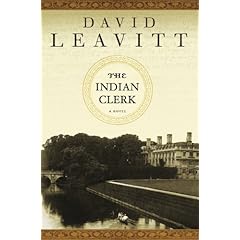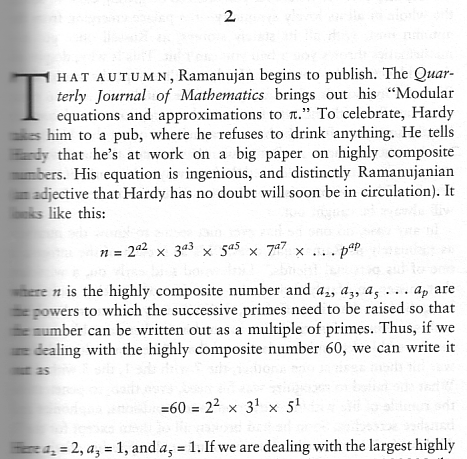David Leavitt's “The Indian Clerk”
December 12, 2007
Roscoe, N.Y.
Famous physicists and mathematicians sometimes receive letters, essays, and even entire treatises from people who have no formal education in these fields, but who nonetheless believe that they have unique insights into the great unsolved problems of our time. The technical term for a person who sends such a package is "crank," and if the recipients of crank letters pause just a few seconds before dropping the masterpiece into the trash, it is because everyone knows the story of Srinivasa Ramanujan (1887 – 1920).
Ramanujan, born in Tamil Nadu, India, was largely self-taught in mathematics. While working as a clerk in Madras, he did mathematics on his own — much of it very unusual and some of it hovering on that fine line that surrounds genius. He sent his stuff to three professors at Cambridge University, but only G. H. Hardy (1877 – 1947) recognized the brilliance of Ramanujan's work. Hardy arranged for Ramanujan to come to England, where he lived and worked until moving back to India in 1919.

David Leavitt's enjoyable new novel The Indian Clerk is a fictional recreation of these events told mostly from Hardy's perspective: The novel begins when Hardy receives Ramanujan's letter in January 1913 and ends when Ramanujan leaves England. The narrative is punctuated by excerpts of lectures that Hardy gave at Harvard in 1936 about Ramanujan, but what Leavitt supplies in these chapters is what Hardy would have liked to have said rather than what he did say. (The actual lectures were published as a book and are still in print.) This technique allows Leavitt to insert a little first-person narrative into what is mostly a third-person novel.
Leavitt's boldest feat in The Indian Clerk is simply conceiving of G. H. Hardy as a protagonist of a novel. Hardy was a shy, reticent, very private, mostly closeted gay man. Leavitt portrays him as intensely lonely, haunted by the suicide of his former companion Russell Kerr Gaye (1877 – 1909). Gaye is never far from Hardy's thoughts, and he even frequently shows up as a ghost to talk over Hardy's problems.
-
Gaye's hand is all over the room. Grant him this much: he had taste. He picked the Turkey carpet, and soaked the chintz curtains in a bathtub full of tea to give them the look of having hung for years in a country house. He chose the checked fabric for the cushions on Hardy's rattan chair—the very cushions Hardy is sitting on now. All this, even though Hardy was leaving him. Poor Gaye, always so drawn to martyrdom! The old painting of Saint Sebastian he kept over his bed should have been a clue. (p. 65-6)
In Leavitt's conception, part of Hardy's motivation in bringing Ramanujan to England is that he is smitten with him, and Hardy becomes secretly jealous of anyone else who seems to get close to Ramanujan. In Hardy's retrospective from the 1936 vantage point, he acknowledges that Ramanujan has eclipsed even his own career. It is only because of Ramanujan that Hardy has been invited to speak at Harvard, and that's all that his audience wants to hear.
Leavitt's novel is filled with detail about Hardy and his times, including Hardy's famous long-time mathematical collaboration with J. E. Littlewood (1885 – 1977) that consisted largely of the exchange of postcards. Anyone who knows a bit about Hardy during this period, or who has read Hardy's A Mathematician's Apology and C. P. Snow's introduction to that book, will recognize little details here and there. Levitt has included a seven-page "Sources and Acknowledgements" at the end of the novel; several books he mentions are now on my reading list.
Leavitt is very good at evoking the milieu of 1910's Cambridge. Early on we go inside a meeting of the Cambridge Apostles, the secret elite society dedicated to debating philosophy and aesthetics while eating sardines on toast. Much of the novel takes place against the background of the Great War. The war prevents Ramanujan from going back to India, leaves the classrooms of Cambridge half empty, and divides the college into pro-war and anti-war factions.
Bertrand Russell had been introduced as a character early on in The Indian Clerk, so we know that the novel will deal with the anti-war activities that caused him to be dismissed from Cambridge. (Hardy's little pamphlet about the subject, Bertrand Russell & Trinity: A College Controversy of the Last War, was privately printed by the Cambridge University Press in 1942, and reissued in facsimile in 1970.) Hardy's attitude towards the war is rather complex; like Russell he is a pacifist and opposed to the war (although much of his anti-war activities involve supporting Russell), but he cannot justify being a conscientious objector, so he tries to enlist and is turned down for medical reasons.
The war also interfered with mathematics:
-
Littlewood has of late made another important discovery. It has to do with a refinement that Riemann made of Gauss's formula for counting primes.... This discovery is of vast importance to about twenty people. Unfortunately, half of those people are in Germany. (p. 177)
Because Leavitt has taken such obvious care with the historical details, it's disturbing to see the pages of The Indian Clerk sometimes marred by bad typesetting. Here's a chunk of page 215:

In the first formula, the exponents should have subscripted indices (as they appear in the sentence that follows); the second formula is preceded by an extraneous equal sign. I continue to be amazed that old math books have pages and pages of formulas that are typeset just fine, but formulas have become a difficult challenge for today's publishers who do not specialize in math books.
Leavitt is not a mathematician, but he can certainly evoke some of the psychology and romance of mathematics:
-
As Ramanujan has learned the hard way—as every mathematician has learned the hard way—the world of numbers brooks neither compromise nor shortcut. You cannot cheat them. You will always be caught out.
-
In any case, no one he [Hardy] has ever met seems to know the numbers as intimately as Ramanujan does. "It's as if each of the integers is one of his personal friends," Littlewood said early on, a witticism that misses, in Hardy's view, the eroticism of working with numbers, the heat that rises off them, their vibrancy and unpredictability and, sometimes, danger.... All his life 7 has been his [Hardy's] favorite number. Despite his atheism, he respects its mystic allure, just as he respects the less salubrious association carried by two other numbers that he refuses to speak, must less write down. It's not that he believes in the specific superstitions; it's that he's convinced that the numbers themselves give off vapors of malevolence. Other numbers that most people would consider perfectly benign he also despises: 38. And 404. And 852. Still others he loves. He loves nearly all the primes. He loves, for reasons that elude him, 32,671.
A lot of name-dropping goes on in this novel, and it helps to be a bit familiar with the cast of characters. Littlewood and Bertrand Russell are major characters, of course, but Lytton Strachey and John Maynard Keynes show up often as well. Ludwig Wittgenstein and D. H. Lawrence make cameo appearances, as well as the black bear at the London Zoo named Winnepeg and nick-named Winnie, who became (via Christopher Milne's teddy bear) A. A. Milne's Winnie-the-Pooh.
On page 51 "the Stephen sisters" are mentioned. The reference is to the two daughters of Leslie Stephen (1832 – 1904), the author of the still-valuable History of English Tought in the Eighteenth Century (1876), but whose career has long since been overshadowed by those two daughters, better known by their married names, Vanessa Bell and Virginia Woolf.
The two Cambridge professors who ignored Ramanujan's letters are identified simply as "Baker and Hobson" (p. 147), and with a start I realized that I knew who Hobson was: E. W. Hobson (1856 – 1933) wrote the highly regarded and influential 1907 text, Theory of Functions of a Real Variable and the Theory of Fourier's Series ( full text from Google Book Search). I know this because Alan Turing's paper "On Computable Numbers..." (which is the subject of my forthcoming book The Annotated Turing) uses the second edition of Hobson's book as the source for Georg Cantor's first proof of the non-enumerability of real numbers. I also have a copy of E. W. Hobson's little 1913 book Squaring the Circle: A History of the Problem, which has also found its way into The Annotated Turing.
Here's one final passage from The Indian Clerk that just has to be based on an actual anecdote. During the war, Littlewood is calculating missile trajectories for the Royal Garrison Artillery and he meets up with Hardy.
-
"I've got something to show you." Littlewood reaches into his bag. "It's my first ballistics paper. Just printed. See that little speck at the bottom of the first page?"
-
"Yes, what is it?"
-
"A tiny sigma. The last line was supposed to read, 'Thus σ should be made as small as possible.'" Littlewood leans back. "Well, the printer did his job. He must have scoured the prints shops of London to find one so tiny."
I suppose it's not just in recent years that publishers find the typesetting of mathematics so challenging.